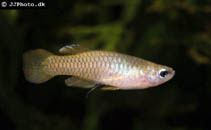|
Lacustricola hutereaui (Boulenger, 1913) Meshscaled topminnow |

|
|
photo by
JJPhoto |
| Family: | Procatopodidae (African lampeyes), subfamily: Procatopodinae | |||
| Max. size: | 3.5 cm TL (male/unsexed) | |||
| Environment: | benthopelagic; freshwater; pH range: 6.5 - 7.19999980926514, non-migratory | |||
| Distribution: | Africa: two distinct population groups; a northern in the drainage systems of Lake Chad and the Chari River in Chad; Ubangi, Kotto, Bamingui and Gribingi river systems in Central African Republic; upper and middle White Nile in Sudan; Uele and Itimbiri in northern Democratic Republic of the Congo (Ref. 47311). Also in Wagenia Falls in Democratic Republic of the Congo (Ref. 106245). Southern populations are found in the Sankuru, Lake Mweru Wantipa and Lufira River in southeastern Democratic Republic of the Congo; Lake Mweru Wantipa and Lake Bangweulu in northern Zambia, and the upper Zambezi in western Zambia; upper Zambezi, Kwilu, upper Kasai and Kwando in Angola; Chobe River and Okavango swamps in Namibia and Botswana; lower Shire in southern Malawi; some river systems flowing into the Indian Ocean in Mozambique (Ref. 47311). Okavango and Pungwe-Buzi systems (Ref. 7248, 52193). Zimbabwe, South Africa (Ref. 27139). | |||
| Diagnosis: |
Dorsal spines (total): 0-0; Dorsal soft rays (total): 7-9; Anal spines: 0-0; Anal soft rays: 11-16. Diagnosis: Lacustricola hutereaui is easily distinguished from L. chobensis and L. pygmaeus by the possession of a ventral arm in the posttemporal bone vs. ventral arm absent, a sharp ventral process in the maxilla vs. ventral process absent, retroarticular smaller than anguloarticular ventral arm vs. about the same size, a lachrymal without a posteroventral extension vs. posteroventral extension present, and by a sinuous cleithrum posterodorsal flap vs. flap rounded (Ref. 123968). Description: Body short and deep, caudal peduncle length 1.0-1.5 times in depth (Ref. 52193). Dorsal fin with 7-9 rays; anal fin with 11-16 rays; caudal fin rounded (Ref. 28714, 52193). Scales in longitudinal series 23-25 (Ref. 28714, 52193). Lacustricola hutereaui is the only species to present the anterior portion of the infraorbital canal closed, with four pores, the mandibular canal closed, with four pores, and the neuromasts placed in deep grooves (Ref. 123968). Colouration: It is possible to note the lack of intense bluish green bright metallic colouration in the flank and the presence of an intense orange colouration in the anal, dorsal, and caudal fins (Ref. 123968). Colour translucent yellowish with light iridescent blue reflections from scales, iris of eye iridescent turquoise, sooty pigment on scale edges gives mesh effect, basal sections of dorsal, anal and caudal fins with dark brown blocks (Ref. 52193). |
|||
| Biology: | Found in small rivers, brooks, swamps and shallow lake parts among vegetated areas (Ref. 3788). Strictly a floodplain or marsh-loving species (Ref. 7248, 52193). Not a seasonal killifish (Ref. 27139). Is difficult to maintain in aquarium (Ref. 27139). | |||
| IUCN Red List Status: | Least Concern (LC); Date assessed: 06 June 2019 Ref. (130435) | |||
| Threat to humans: | harmless | |||